Financial Reporting Assignment
Added on 2023-04-20
43 Pages8493 Words72 Views
1
Financial reporting assignment
Financial reporting assignment
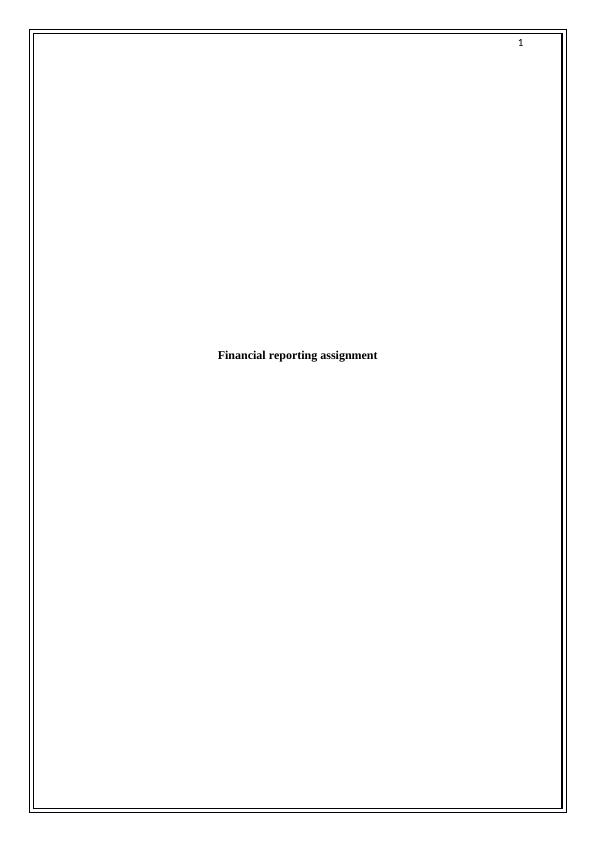
2
Executive Summary
The period of financial crises has impacted most of the businesses worldwide and
cause the need for developing the business strategies that help them to sustain the robust
profitability during the period of crises. The civil aviation market is most important as it is
the prime movers in the economic growth and the strategic element for employment
generation. Aim of this report is to evaluate the case of British Airways and KLM Royal
Dutch Airlines in order to report on the financial performance and risk position of these
companies. Financial analysis through use of ratio analysis has been carried out for both the
companies for last two years and it has also been compared with industry average.
Executive Summary
The period of financial crises has impacted most of the businesses worldwide and
cause the need for developing the business strategies that help them to sustain the robust
profitability during the period of crises. The civil aviation market is most important as it is
the prime movers in the economic growth and the strategic element for employment
generation. Aim of this report is to evaluate the case of British Airways and KLM Royal
Dutch Airlines in order to report on the financial performance and risk position of these
companies. Financial analysis through use of ratio analysis has been carried out for both the
companies for last two years and it has also been compared with industry average.
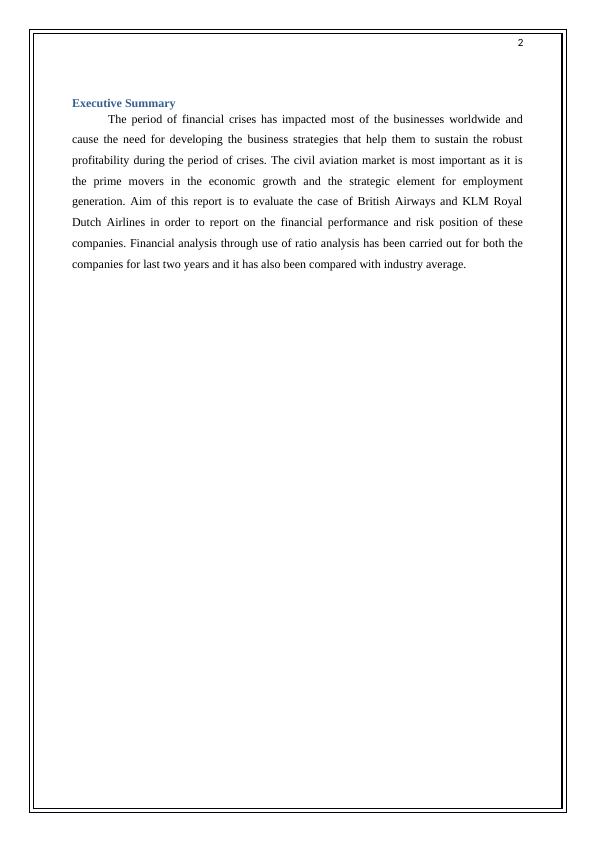
3
Contents
Executive Summary...................................................................................................................2
Part 1: Introduction....................................................................................................................4
Case of British Airways..........................................................................................................4
Case of KLM Royal Dutch Airlines.......................................................................................5
Part 2: Analysis of financial statements for last 5 years............................................................5
Financial Ratio analysis – Comparison of the two companies and industry..........................5
2.1: Profitability Ratios..............................................................................................................5
2.1.1: Return on assets............................................................................................................5
2.1.2: Return on Equity (ROE)...............................................................................................6
2.1.3: Return on Capital Employed (ROCE)..........................................................................7
2.1.4: Gross Profit Margin......................................................................................................9
2.1.5: Net profit Margin........................................................................................................10
2.2: Liquidity Ratios.................................................................................................................11
2.2.1: Current ratio...............................................................................................................11
2.2.2: Quick Ratio.................................................................................................................12
2.3: Industry Ratio....................................................................................................................13
2.3.1: Available seat kilometers (ASK)................................................................................13
2.3.2: Revenue passenger kilometers (RPK)........................................................................14
2.3.3: Passenger load factor..................................................................................................15
2.4: Asset efficiency Ratios......................................................................................................16
2.4.1: Average inventories turnover period..........................................................................16
2.4.2: Average settlement period for receivables.................................................................17
2.4.3: Average settlement period for payables.....................................................................18
2.5: Gearing Ratio....................................................................................................................19
2.5.1: Debt to capital ratio....................................................................................................19
2.5.2: Interest cover ratio......................................................................................................20
2.6. Investment ratios...............................................................................................................21
2.6.1: Earnings per Share......................................................................................................21
2.6.2: Price/Earnings ratio....................................................................................................23
2.6.3: Dividend payout ratio.................................................................................................24
2.6.4: Dividend cover ratio...................................................................................................25
Contents
Executive Summary...................................................................................................................2
Part 1: Introduction....................................................................................................................4
Case of British Airways..........................................................................................................4
Case of KLM Royal Dutch Airlines.......................................................................................5
Part 2: Analysis of financial statements for last 5 years............................................................5
Financial Ratio analysis – Comparison of the two companies and industry..........................5
2.1: Profitability Ratios..............................................................................................................5
2.1.1: Return on assets............................................................................................................5
2.1.2: Return on Equity (ROE)...............................................................................................6
2.1.3: Return on Capital Employed (ROCE)..........................................................................7
2.1.4: Gross Profit Margin......................................................................................................9
2.1.5: Net profit Margin........................................................................................................10
2.2: Liquidity Ratios.................................................................................................................11
2.2.1: Current ratio...............................................................................................................11
2.2.2: Quick Ratio.................................................................................................................12
2.3: Industry Ratio....................................................................................................................13
2.3.1: Available seat kilometers (ASK)................................................................................13
2.3.2: Revenue passenger kilometers (RPK)........................................................................14
2.3.3: Passenger load factor..................................................................................................15
2.4: Asset efficiency Ratios......................................................................................................16
2.4.1: Average inventories turnover period..........................................................................16
2.4.2: Average settlement period for receivables.................................................................17
2.4.3: Average settlement period for payables.....................................................................18
2.5: Gearing Ratio....................................................................................................................19
2.5.1: Debt to capital ratio....................................................................................................19
2.5.2: Interest cover ratio......................................................................................................20
2.6. Investment ratios...............................................................................................................21
2.6.1: Earnings per Share......................................................................................................21
2.6.2: Price/Earnings ratio....................................................................................................23
2.6.3: Dividend payout ratio.................................................................................................24
2.6.4: Dividend cover ratio...................................................................................................25
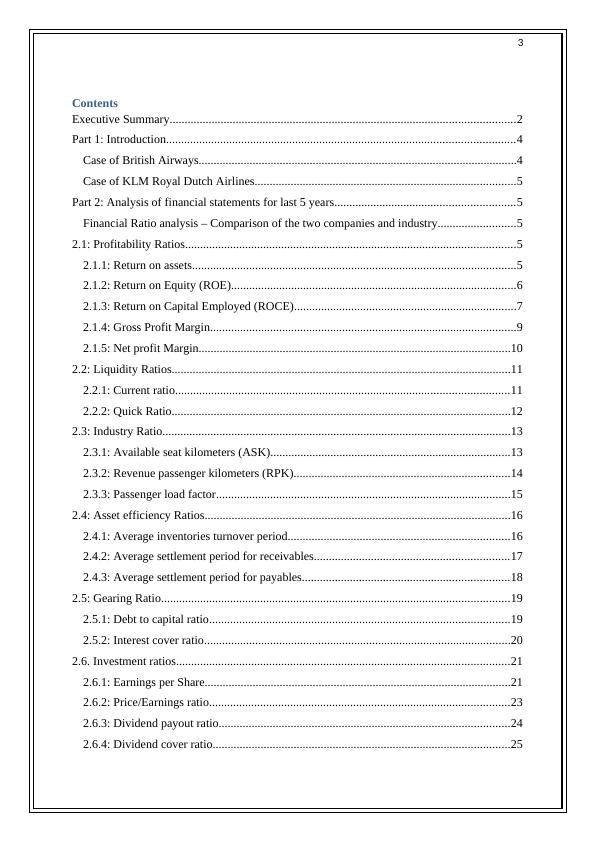
4
3. Cash-Flow Analysis.............................................................................................................26
3.1: Operating Cash-Flow / Sales.........................................................................................26
3.2: CF from borrowings / Sales...........................................................................................27
3.3: Operating CF after tax/ (Fixed assets investment +Dividends)....................................28
Part 4: Recommendations........................................................................................................29
Part 5: Conclusion....................................................................................................................29
Part 6: References....................................................................................................................30
Appendixes...............................................................................................................................32
3. Cash-Flow Analysis.............................................................................................................26
3.1: Operating Cash-Flow / Sales.........................................................................................26
3.2: CF from borrowings / Sales...........................................................................................27
3.3: Operating CF after tax/ (Fixed assets investment +Dividends)....................................28
Part 4: Recommendations........................................................................................................29
Part 5: Conclusion....................................................................................................................29
Part 6: References....................................................................................................................30
Appendixes...............................................................................................................................32

5
Part 1: Introduction
The global financial crises of year 2008 and 2009 have emerged because of the failure
of some of major financial banks and institutions and it has impacted the world economy.
United Kingdom and Europe aviation sector is the most important part of world economy and
it also impacted heavily. Some of financial implication of global financial crises on aviation
sector of United Kingdom and Europe are negative growth rate, high operating cost and huge
debt. The two most valuable companies of the aviation sector of Europe and UK that have
been worst affected are British Airways (BA) and KLM Royal Dutch Airlines (KLM).
The main purpose of this report is to evaluate the case of British Airways and KLM
Royal Dutch Airlines in order to report on the financial performance and risk position of
these companies. Financial performance and risk position has been evaluated through use of
financial ratios and through using the information provided in the annual report. In this
regards financial ratios of last 5 years has been calculated for both the companies and they
have been compared with industry average in order to evaluate their business strategies
during the period of financial crises. During the financial crises period both companies have
make use of management accounting concepts and techniques such as value for money
concept, drive to reduce cost, technological innovation and other techniques to survive the
period of financial crises and to stand for future possibilities. In regards to this, report aims to
explore the potential of strategic management accounting and costing concepts and
techniques that both companies used for survival during the financial crises period and to
make strong base for future in order have comparison with similar companies.
Case of British Airways
The business of British Airways is largely impacted due to the period of global
recession due to occurrence of financial crisis in the year 2007. The sales and profit margins
of the company have depicted a major decline during the financial crisis period. It was unable
to pay nay dividend to its shareholders largely due to its negative profitability position and
operating at loss. The airline was able to overcome from the negative impact of the economic
recession by continued reinvestment in its profits and focusing on long-term growth. This is
largely on account of large-scale investment in launching crisis programs for reducing its
operational costs and aiding quick financial recovery for the company (Hunter, 2019). The
use of effective cost management strategies by the airline has enabled it to reduce its
Part 1: Introduction
The global financial crises of year 2008 and 2009 have emerged because of the failure
of some of major financial banks and institutions and it has impacted the world economy.
United Kingdom and Europe aviation sector is the most important part of world economy and
it also impacted heavily. Some of financial implication of global financial crises on aviation
sector of United Kingdom and Europe are negative growth rate, high operating cost and huge
debt. The two most valuable companies of the aviation sector of Europe and UK that have
been worst affected are British Airways (BA) and KLM Royal Dutch Airlines (KLM).
The main purpose of this report is to evaluate the case of British Airways and KLM
Royal Dutch Airlines in order to report on the financial performance and risk position of
these companies. Financial performance and risk position has been evaluated through use of
financial ratios and through using the information provided in the annual report. In this
regards financial ratios of last 5 years has been calculated for both the companies and they
have been compared with industry average in order to evaluate their business strategies
during the period of financial crises. During the financial crises period both companies have
make use of management accounting concepts and techniques such as value for money
concept, drive to reduce cost, technological innovation and other techniques to survive the
period of financial crises and to stand for future possibilities. In regards to this, report aims to
explore the potential of strategic management accounting and costing concepts and
techniques that both companies used for survival during the financial crises period and to
make strong base for future in order have comparison with similar companies.
Case of British Airways
The business of British Airways is largely impacted due to the period of global
recession due to occurrence of financial crisis in the year 2007. The sales and profit margins
of the company have depicted a major decline during the financial crisis period. It was unable
to pay nay dividend to its shareholders largely due to its negative profitability position and
operating at loss. The airline was able to overcome from the negative impact of the economic
recession by continued reinvestment in its profits and focusing on long-term growth. This is
largely on account of large-scale investment in launching crisis programs for reducing its
operational costs and aiding quick financial recovery for the company (Hunter, 2019). The
use of effective cost management strategies by the airline has enabled it to reduce its
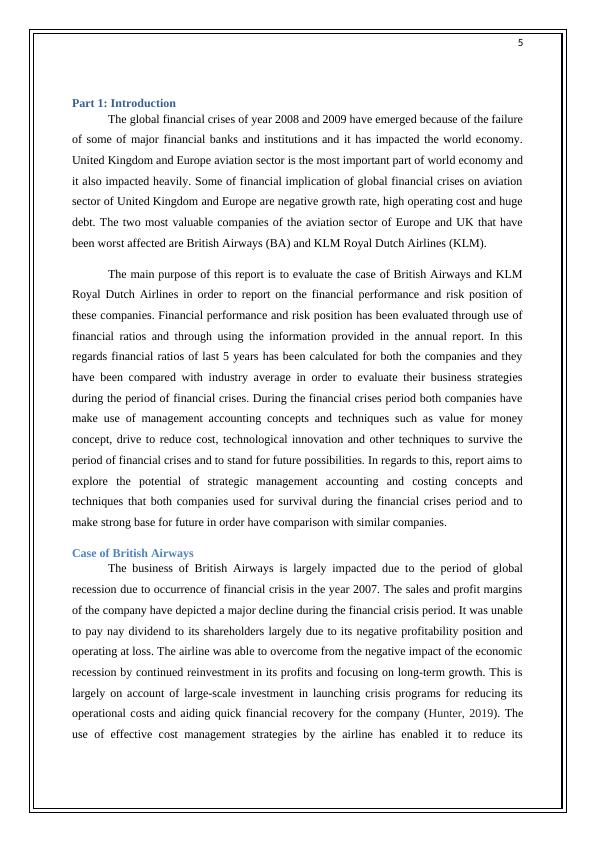
6
operating costs and thus it was able to improve its profitability position and improve the
market share in the highly competitive airline industry.
Case of KLM Royal Dutch Airlines
KLM Royal Dutch Airlines has also effectively responded to the global recession by
the use of adequate cost management strategies. The company operating efficacy has been
largely negatively impacted by the impact of the downturn in the global economy due to the
occurrence of global financial crisis in the year 2007. The reduction in the operating costs has
enabled the company to overcome the decline in its revenue that has occurred mainly due to
the significant impact of the global financial crisis. The airline is also striving to preserve
cash by delaying the investment in the new aircraft and minimizing its capital expenditure.
This is largely done from the perspective of reserving cash and reinvesting in profit for
promoting long-term growth of the company (Done, 2009).
Part 2: Analysis of financial statements for last 5 years
Financial Ratio analysis – Comparison of the two companies and industry
In this section of the report financial analysis of British Airways (BA) and KLM
Royal Dutch Airlines (KLM) has been examined through use of ratio analysis and
comparison has also been made to investigate company’s performance with respect to
industry. The analysis of both the companies have been evaluated from the annual report of
the financial year 2013, 2014, 2015, 2016 and 2017. Financial ratios are the key tools which
is implemented in order to understand the overall financial strength of the company.
Comparison based on the last five years of both the company gives far better picture of the
financial position as a whole.
2.1: Profitability Ratios
Profitability ratios refers to class of financial metrics that is used to evaluate ability of
entity to generate the earnings in relation to some metrics such as sales, capital employed,
assets and equity. These ratios are important from the point of view of investors as well as
from the point of management because it helps with company profitability position during the
relative year (Brigham and Michael, 2013). This ratio helps to measure the effectiveness in
generating the return for both the company for the last five years.
operating costs and thus it was able to improve its profitability position and improve the
market share in the highly competitive airline industry.
Case of KLM Royal Dutch Airlines
KLM Royal Dutch Airlines has also effectively responded to the global recession by
the use of adequate cost management strategies. The company operating efficacy has been
largely negatively impacted by the impact of the downturn in the global economy due to the
occurrence of global financial crisis in the year 2007. The reduction in the operating costs has
enabled the company to overcome the decline in its revenue that has occurred mainly due to
the significant impact of the global financial crisis. The airline is also striving to preserve
cash by delaying the investment in the new aircraft and minimizing its capital expenditure.
This is largely done from the perspective of reserving cash and reinvesting in profit for
promoting long-term growth of the company (Done, 2009).
Part 2: Analysis of financial statements for last 5 years
Financial Ratio analysis – Comparison of the two companies and industry
In this section of the report financial analysis of British Airways (BA) and KLM
Royal Dutch Airlines (KLM) has been examined through use of ratio analysis and
comparison has also been made to investigate company’s performance with respect to
industry. The analysis of both the companies have been evaluated from the annual report of
the financial year 2013, 2014, 2015, 2016 and 2017. Financial ratios are the key tools which
is implemented in order to understand the overall financial strength of the company.
Comparison based on the last five years of both the company gives far better picture of the
financial position as a whole.
2.1: Profitability Ratios
Profitability ratios refers to class of financial metrics that is used to evaluate ability of
entity to generate the earnings in relation to some metrics such as sales, capital employed,
assets and equity. These ratios are important from the point of view of investors as well as
from the point of management because it helps with company profitability position during the
relative year (Brigham and Michael, 2013). This ratio helps to measure the effectiveness in
generating the return for both the company for the last five years.
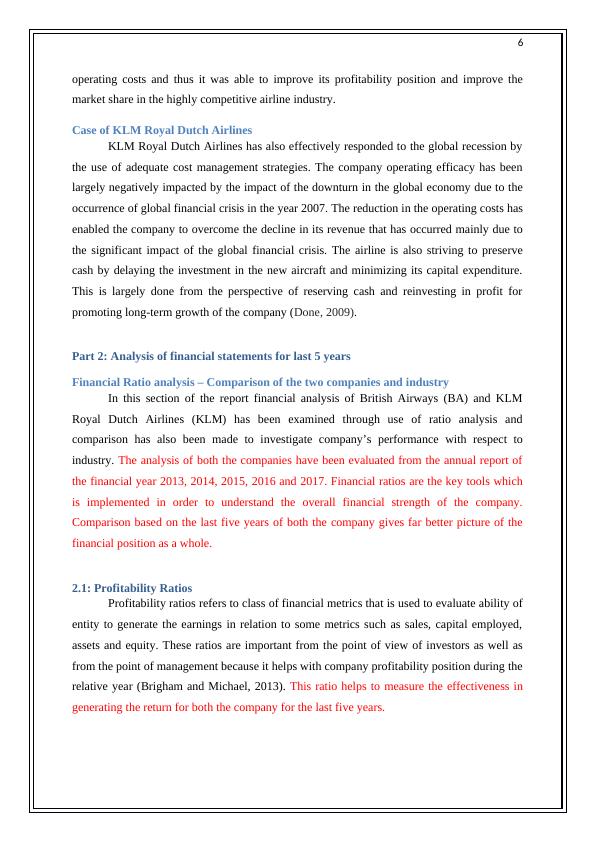
7
2.1.1: Return on assets
Return on assets is the popular profitability ratio that provides the percentage of profit
earned on the average total assets of the company. This ratio measures the amount of profit
generated by the company from the assets utilized in the business. It further evaluates the
efficiency of the management system of the company in generating earning from the
available economic resources or assets from the balance sheet. Operating profit of both the
company is obtained from the income statement and further the asset is obtained from the
balance sheet.
Return on Assets (ROA) =Operating profit (EBIT)/Total assets *100
2013 2014 2015 2016 2017
BA 5.94 7.26 8.06 8.58 10.07
KLM 2.60 10.01 5.21 7.58 (10.52)
Industry
average 4.00 7.86 8.97 9.19 6.26
(British Airways, 2013 to 2017 and KLM Royal Dutch Airways, 2013 to 2017)
2013 2014 2015 2016 2017
(15.00)
(10.00)
(5.00)
-
5.00
10.00
15.00
Return on Assets
On the basis of calculation of return on assets of both companies together with
industry average clearly reflects that there was increasing trend in this ratio from year 2013 to
2.1.1: Return on assets
Return on assets is the popular profitability ratio that provides the percentage of profit
earned on the average total assets of the company. This ratio measures the amount of profit
generated by the company from the assets utilized in the business. It further evaluates the
efficiency of the management system of the company in generating earning from the
available economic resources or assets from the balance sheet. Operating profit of both the
company is obtained from the income statement and further the asset is obtained from the
balance sheet.
Return on Assets (ROA) =Operating profit (EBIT)/Total assets *100
2013 2014 2015 2016 2017
BA 5.94 7.26 8.06 8.58 10.07
KLM 2.60 10.01 5.21 7.58 (10.52)
Industry
average 4.00 7.86 8.97 9.19 6.26
(British Airways, 2013 to 2017 and KLM Royal Dutch Airways, 2013 to 2017)
2013 2014 2015 2016 2017
(15.00)
(10.00)
(5.00)
-
5.00
10.00
15.00
Return on Assets
On the basis of calculation of return on assets of both companies together with
industry average clearly reflects that there was increasing trend in this ratio from year 2013 to

8
2017. Return on assets ratio of BA from year 2013 to 2017 have increased each year from
5.94% in year 2013 to 10.07% in year 2017. It means BA has used assets more precisely as
compared to KLM. The return on assets ratio of KLM was above industry average during the
last five years and on the other hand, return on asset of KLM was below industry average. So,
BA has provided better return on assets as compared to KLM in all the five years under
review.
2.1.2: Return on Equity (ROE)
This ratio measures the percentage of profit earned on total book value of equity
invested by the company during the year. This ratio is significant for investors as they want to
have information on holding period return earned by them on their investment. However this
ratio is not the correct measure of total return earned by the investors, so this ratio is
moreover depicts the use of equity capital to generate the profit.
Return on equity (ROE) =Net profit/Total equity*100 (Damodaran, 2011)
2013 2014 2015 2016 2017
BA 11.45 33.43 54.55 31.71 23.49
KLM 8.26 3,788.89 13.64 52.53 (75.84)
Industry
average 45.50 44.40 52.27 40.08 27.96
(British Airways, 2013 to 2017 and KLM Royal Dutch Airways, 2013 to 2017)
2017. Return on assets ratio of BA from year 2013 to 2017 have increased each year from
5.94% in year 2013 to 10.07% in year 2017. It means BA has used assets more precisely as
compared to KLM. The return on assets ratio of KLM was above industry average during the
last five years and on the other hand, return on asset of KLM was below industry average. So,
BA has provided better return on assets as compared to KLM in all the five years under
review.
2.1.2: Return on Equity (ROE)
This ratio measures the percentage of profit earned on total book value of equity
invested by the company during the year. This ratio is significant for investors as they want to
have information on holding period return earned by them on their investment. However this
ratio is not the correct measure of total return earned by the investors, so this ratio is
moreover depicts the use of equity capital to generate the profit.
Return on equity (ROE) =Net profit/Total equity*100 (Damodaran, 2011)
2013 2014 2015 2016 2017
BA 11.45 33.43 54.55 31.71 23.49
KLM 8.26 3,788.89 13.64 52.53 (75.84)
Industry
average 45.50 44.40 52.27 40.08 27.96
(British Airways, 2013 to 2017 and KLM Royal Dutch Airways, 2013 to 2017)

End of preview
Want to access all the pages? Upload your documents or become a member.
Related Documents
Finance Reporting and Accounting Managementlg...
|18
|4346
|208
REPORT ON ANALYSIS OF THE FINANCIAL REPORTS.lg...
|35
|10207
|84
Analysis of Financial Reports in Airline Industrylg...
|38
|9437
|237
Recent Developments in International Finance and its Impact on British Airwayslg...
|20
|3814
|227
Corporate Financial Managementlg...
|40
|7115
|87
Explore Types of Financial Statements and Budgets in Travel and Tourism Industrylg...
|7
|1243
|76
